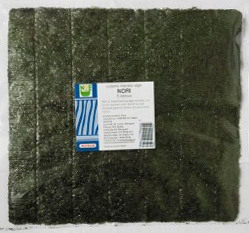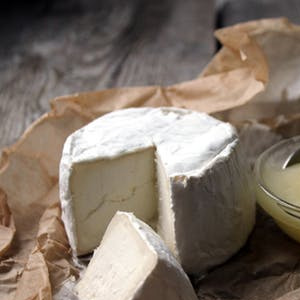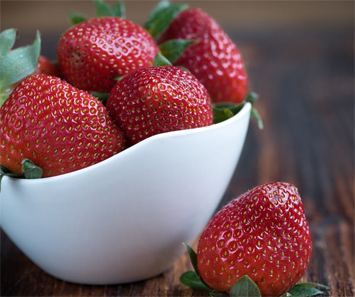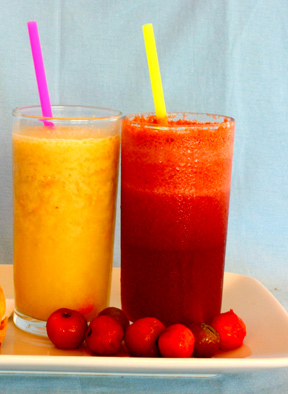Juicing for Iodine: What Foods are Rich in Iodine

Iodine is a very important mineral. In fact, iodine is a chemical element, and it turns out that it is the heaviest element essential for our life. Within the human body, it is a part of the thyroid hormones.
Among other things, it helps the thyroid gland to function properly, which in turn promotes the proper metabolic function of the human body. When there is not enough iodine in the body, the production of thyroid hormones is impaired. The most common thyroid problems are iodine related problems.
When there is not enough iodine in the body, various physical and mental problems may occur. For example, one has an increased risk of cancer, one may easily gain weight, and the levels of cholesterol are increased. On the mental plane, there is the risk of mental retardation, depression, and lethargy.
 Therefore, it is an imperative to make sure you take a lot of foods rich in iodine. This is true despite the fact that today we can buy table salt with added iodine as iodized salt. While it certainly helps using iodized salt, much better is if you can get the entire nutritive package, that is, iodine in its natural nutritious dense environment.
Therefore, it is an imperative to make sure you take a lot of foods rich in iodine. This is true despite the fact that today we can buy table salt with added iodine as iodized salt. While it certainly helps using iodized salt, much better is if you can get the entire nutritive package, that is, iodine in its natural nutritious dense environment.
So what’s the largest source of iodine rich food? The ocean. Seawater is the most abundant supply of iodine on our planet.
That’s why the first place on this list is reserved for seafood.
Table of Contents
Seafood
There is absolutely no other food that can match seafood as a source of iodine (or other important nutrients for that matter). For example, oysters, shrimps, lobsters, cod, etc. are great sources. For vegetarians, there are the various types of seaweed and algae. Sea Kelp (the large type of seaweeds), and Kombu (Laminaria) are two of the best iodine source.
That being said, be careful NOT to take too much iodine. Too much iodine can be toxic and can pose a problem. This may happen if you use too much of either kombu or kelp. Nori (Porphyra) is not so rich in iodine and it can be safely consumed. Wakame (Undaria) is somewhere in the middle between these two groups. Here is a quick overview of the average quantities of iodine found in algae:
- Nori: 15 micrograms of iodine per gram of dried nori
- Wakame: 40 micrograms of iodine per gram of dried wakame
- Hijiku: 470 micrograms of iodine per gram of dried hijiku
- Kombu: 2300 micrograms of iodine per gram of dried kombu
- Kelp flakes: 8000 of iodine per gram of dried sea kelp

Dried Nori Algae
The recommended daily intake of iodine is 150 micrograms for adult persons. For pregnant women, the value is somewhat higher, about 220 micrograms, and lactating women should take about 290 micrograms of iodine.
The values are given for dried seaweed because that’s probably the form you are going to obtain and use them in most cases.
So, as you can see, large quantities of kombu and kelp can provide too much iodine, so be careful. Make sure you boil your seaweed and throw out the water afterward. Heat treatment will diminish the iodine content, as opposed to raw seaweed.
The other thing to be careful about is to buy seaweed harvested from pure, uncontaminated waters.
Watercress
This plant native to European and Asian aquatic environments, grows very fast and is considered one of the first leafy vegetables eaten by humans. It is a powerhouse of nutrients, and one of the more abundant is iodine. If you are vegetarian or vegan, you should include watercress in your diet as a source of iodine.
Eggs
Eggs can be great source of iodine mineral (and selenium by the way). Just make sure you purchase free range eggs. I’m very skeptical of the nutritional content of caged eggs. One pastured egg can have approximately 30 micrograms of iodine.
Dairy
 Dairy is another good iodine-rich source. But, above all, we are talking about raw, unpasteurized diary. It could very well be that dairy is the main source of this important nutrient in today’s standard diet, albeit probably not in the raw form. As diary, logically, comes from animals that by definition have to be free to graze, avoid produce from industrial farming and grain fed animals. Only animals that are raised on grass can have healthy amounts of iodine an other healthy nutrient. For example, mozzarella cheese from pastured milk is a great source of iodine.
Dairy is another good iodine-rich source. But, above all, we are talking about raw, unpasteurized diary. It could very well be that dairy is the main source of this important nutrient in today’s standard diet, albeit probably not in the raw form. As diary, logically, comes from animals that by definition have to be free to graze, avoid produce from industrial farming and grain fed animals. Only animals that are raised on grass can have healthy amounts of iodine an other healthy nutrient. For example, mozzarella cheese from pastured milk is a great source of iodine.
Salt
As we already indicated, iodine is present in table salt. However, not all brands of table salt are iodized. For example, our preferred choice of salt is the pink Himalayan salt. But it is not iodized. So, if you are buying salt for its iodine content, check the labels before purchasing.
Vegetables
Some vegetables contain more iodine than others. But the actual amount varies greatly. As the plant itself cannot synthesize iodine from other chemical elements, it has to absorb it from the ground. As a result, the condition of the soil determines how much iodine is the vegetables. Typical sources of iodine among the veggies are: spinach, artichoke, peas, broccoli, cauliflower, soybean, and beans. At the same time, some of them may have a potential to interfere with iodine absorption, like soybean and cauliflower, for example.
Fruits
 Fruits can also be abundant sources of iodine. For example, strawberries, cranberries, dates, figs, pineapple, coconut, grapefruit, kiwi, apricots, all contain some amounts of iodine in them.
Fruits can also be abundant sources of iodine. For example, strawberries, cranberries, dates, figs, pineapple, coconut, grapefruit, kiwi, apricots, all contain some amounts of iodine in them.
For example, a cup of cranberries contains about 800 micrograms of iodine. Or, one cup of strawberries has about 15 micrograms. Try to purchase them fresh and organic, for example on the farmer’s market. Or use quality juices. One option is using cranberry juice without extra added sugar.
Beverages
Some drinks more than others contain iodine. If we disregard juicing for a moment (see below) as the best option, we can say that black tea and coffee are good options. Now, caffeine is present in both tea and coffee. Caffeine can have some adverse health effects. If you know your personal caffeine tolerance, feel free to use these beverages to fulfill your iodine requirements.
Other Sources
Other sources can be spices and herbs. If you use, for example, cinnamon, black pepper, fennel, or hyssop regularly, they can be good source of this important mineral.
Beware of Bromine
Bromines compete with iodine for the same receptors in the thyroid gland. That’s why you should minimize your exposure to bromine.
Bromines are everywhere around us. They are part of soft drinks and sodas (why would you need them in the first place), pesticides (buy organic food), plastics (drink your water from glass containers), bakery goods, medications, etc.
As iodine levels in your body can drop significantly because of exposure to bromine, it is important to clear up your food sources and your environment. You will never be successful 100 percent (just like you can never totally reduce your exposure to air pollution), but you can try to minimize the risks by minimizing your exposure.
Juicing for Iodine
 Based on the above considerations, it shouldn’t be too difficult to prepare iodine rich juices or smoothies. For example, one obvious method could be adding yogurt in your smoothies as a source of calcium and iodine. Make sure, however, that you have organic yogurt from grass–fed cattle.
Based on the above considerations, it shouldn’t be too difficult to prepare iodine rich juices or smoothies. For example, one obvious method could be adding yogurt in your smoothies as a source of calcium and iodine. Make sure, however, that you have organic yogurt from grass–fed cattle.
Here are some other suggestions about drinks that can help you to stimulate your thyroid gland into action.
Cranberry Detox Juice
This is a great detox cranberry juice recipe. It is cleansing and delicious and the cranberries and fennel combined deliver just enough iodine for your thyroid to function better.
Ingredients:
- 1 cup organic cranberries
- 1/2 fennel bulb
- 1 organic apple
- 1 inch turmeric root, peeled
Juice the ingredients up and enjoy.
Cranberry and Peach Water Recipe
With cranberries as the major source of iodine, this can be a great home made drink. In addition to iodine, you will get some healthy amounts of vitamin C.
Ingredients:
1 cup Organic Cranberries
1/2 Organic Peach, chopped
1 Organic Lemon, peeled and chopped
Clean Water
Put in the water and let it sit there for half an hour. If you have time you can extend the duration, as the longer it sits, the better its taste will be.
Seaweed Smoothie
As seaweed is probably one of the best sources of iodine, why don’t we use it to prepare a great green smoothie? One idea is to use your favorite green smoothie recipe. Then, replace or augment the spinach or kale with seaweed. The only thing you should be careful of is how much seaweed you put in there. Use the above table of iodine content in the different varieties of seaweed to determine the quantity.
Key Takeaway Points About Iodine
Iodine is a vital nutrient, especially important for the proper functioning of your hormonal system. Above all, it affects the thyroid gland.
Too little or too much iodine can equally be harmful, but more likely are you are not getting enough of it.
You can get too much iodine from food, for example, if you consume seaweed in excess on a consistent basis.
Some fruits and vegetables can be good sources of iodine, and you can use these in preparing juices and smoothies. However, their actual iodine contents depends on the growth conditions.

I am trying to find out if you can get too much iodine by drinking cranberry juice (no sugar added). Specifically ocean spray 100 percent cranberry juice.
You are right. Cranberries are packed with iodine. I don’t know about the specific brand you mention, but some people claim 150 ml of cranberry juice could contain as much as 400 mg of iodine. I guess if your juice has similar concentrations, you have to be careful not to get too much iodine, especially if you consume it day in day out.
According to what I remember reading in the book:
Dr. Atkins’ Vita-Nutrient Solution : Nature’s Answer to Drugs by Robert C. Atkins
Kelp will not overdose a person on iodine the way iodine mineral supplements could. Maybe cranberry is similarly safe?
Yes, it makes sense. I have no idea about cranberries, but it somehow seems to me unlikely that they can contain high doses of iodine anyways.